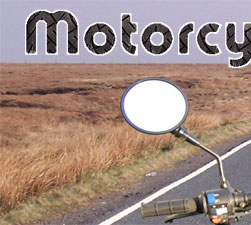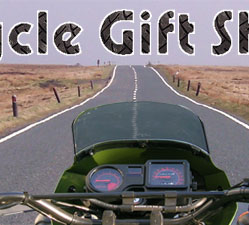|
The most common setup is to have a lever on the right handgrip to engage the front brake and a pedal near the right foot peg to engage the rear brake. Standard motorcycle brakes are hydraulically actuated to clamp down on the brakes rotors. The front brakes supply about 70% of the motorcycle's stopping power (car brakes are similarly proportioned. One common misconception is that using too much front brake can flip the rider over the handlebars. Despite the greater braking capabilities of a motorcycle's front brakes it is very difficult to make a flip a bike based on braking alone. To stop a motorcycle in the shortest distance possible, it is important to use both front and rear brakes in unison. Danger can arise when misuse of the brakes locks a wheel and causes the tire to skid. When skidding, control over the motorcycle is compromised.
To avoid a tire skid, motorcycle brakes should be applied firmly but smoothly. Progressively applying the front brake allows the weight of the motorcycle to shift forward, giving that tire extra traction. It is important to avoid abrupt application of the rear brake because as the weight shifts forward, decreasing weight on the rear tire makes it easier to lock up. In the event of a skid, a rider only has a split second to react so knowing the proper procedure is key.
A motorcycle's front tire is mainly responsible for steering the motorcycle. If the motorcycle's front tire locks up during braking, there will not be traction to facilitate steering. If your motorcycle's front wheel locks up, you should immediately release the brake and then reapply less abruptly.
A motorcycle's rear tire is mainly responsible for powering the motorcycle. Despite the fact that bikes only have two wheels, they are pretty stable as long as it is under power. As long as the rear wheel is driving the motorcycle, its rotational force will keep it upright and the wheels in line with each other. If the rear wheel locks up during braking, it will naturally drift out of line with the front wheel. If you release the brake and allow the rear wheel to spin under the power of the engine again, it will try to snap it back in line with the front wheel. This can cause a motorcycle to high side and can throw the rider off. High side crashes can be one of the most dangerous situations a motorcycle rider can encounter. If your motorcycle's rear wheel locks up, keep pressure of the brake. It is better to allow the rear wheel to skid than to risk a high side crash.
In most braking situations, the rider should
downshift as speed decreases to keep the road speed synched
up with the engine speed. In emergency situations, keep
the clutch squeezed in and focus on braking. Before coming
to a stop, however, make sure to shift all the way down
to first gear. Normally, it is a good idea to keep the motorcycle
in gear with the clutch in at stoplights. With the bike
in first gear, the rider has more control and can get the
vehicle moving quickly if necessary.
The best way to make sure
stopping on your motorcycle is as safe as possible is to
maintain a safe following distance behind the vehicle in
front of you. By keeping an adequate space cushion between
you and other vehicles, you can avoid the need for sudden
breaking altogether. In wet or slippery conditions, increase
your following distance even more since traction available
for braking is reduced.
For more information check out our Motorcycle Brakes Page
|






